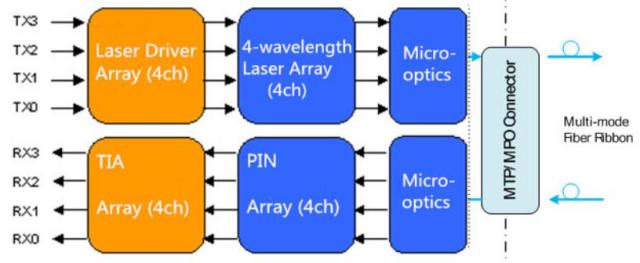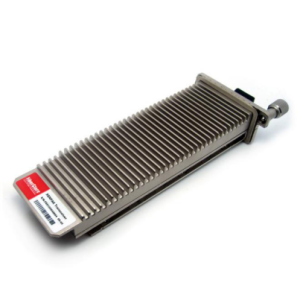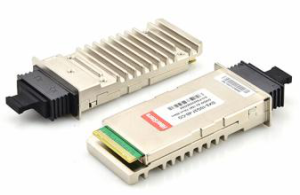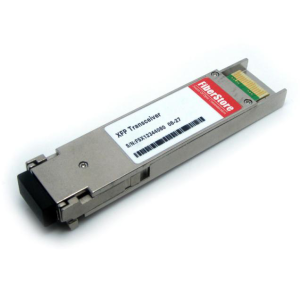Data transmission with higher density and bandwidth has become the trend under today’s networking environment. And for better network performance, the existing bandwidth has been generated to 40Gbps. Among various network devices designed for 40 Gigabit Ethernet (GbE) links, 40G QSFP+ transceivers play an important role in driving the bandwidth to a mounting point. This passage is going to focus on this cost-effective transceiver. First, let’s move on to the overview of 40G QSFP+.
The 40G QSFP+ (Quad Small Form-Factor Pluggable Plus) transceiver is a compact, hot-pluggable, parallel fiber optical transceiver with four independent optical transmit and four receive channels. Each channel is able to transfer data at 10Gbps. Thus, a QSFP+ transceiver with Four high-speed channels can support data rates up to 40Gbps and it supports Ethernet, Fibre Channel, InfiniBand and SONET/SDH standards. In addition, 40G QSFP+ is primarily used in switches, routers, and data center equipment where it provides higher density than SFP+ transceiver.
With the development of the SFF-8436 Multi Source Agreement, many vendors are now offering a variety of IEEE- and MSA-compliant QSFP+ devices for fiber networks. And there are three basic 40G QSFP+ transceivers for this standard: 40G LR4 QSFP+ transceiver, 40G SR4 QSFP+ transceiver and 40G LR4 parallel single mode (PSM) transceiver.
The 40G LR4 QSFP+ Transceiver converts 4 inputs channels of 10Gbps electrical data to 4 CWDM optical signals, and multiplexes them into a single channel for 40Gbps optical transmission. Together with duplex LC connectors, 40G LR4 QSFP+ transceiver can support an optical link length up to 10 kilometers over the single mode fiber.
We can easily understand the working principle of 40G LR4 QSFP+ transceiver from the figure below. In the transmit side, four 10Gbps serial data streams at different wavelengths are passed to laser drivers. Then four data streams are optically multiplexed to a single mode fiber through LC connector. In the receive side, four 10Gbps optical data streams are de-multiplexed into four individual data streams by the optical de-multiplexer. And each data stream is collected by a PIN photodiode /TIA array and passed to an output driver.

The 40G SR4 QSFP+ Transceiver provides a high-bandwidth 40G optical connection over fiber ribbon terminated with MPO/MTP connectors. Unlike the 40G LR4 QSFP+ transceiver, this kind of transceiveris used together with multi-mode fiber, supporting with a link length up to 100 meters on OM3 cable and 150 meters on OM4 cable.
We can easily understand the working principle of 40G SR4 QSFP+ transceiver from the figure below. The transmitter converts parallel electrical input signals into parallel optical signals through the use of a laser array. Then the parallel optical signals are transmitted parallelly through the multi-mode fiber ribbon. Reversely, the receiver converts parallel optical input signals via a photo detector array into parallel electrical output signals.

The 40G LR4 PSM transceiver is designed with QSFP+ form factor, optical/electrical connection and digital diagnostic interface according to the QSFP+ MSA. As a highly integrated 4-channel optical module, this kind of transceiver can provide increased port density and total system cost savings. 40G LR4 PSM transceiver supports up to 10 kilometers over single mode fiber through MPO/MTP fiber ribbon connectors.
From the figure below, we can easily understand the working principle of 40G LR4 PSM transceiver which is nearly the same as that of 40G SR4 QSFP+ transceiver. The transmitter converts parallel electrical input signals into parallel optical signals and the receiver converts parallel optical input signals via a photo detector array into parallel electrical output signals. The difference is that the cable used in this link is single mode ribbon fiber cable. That’s to say, the parallel optical signals are transmitted parallelly through 8 single mode fibers.
When reading this, you may have found that both 40G LR4 QSFP+ transceiver and 40G QSFP+ PSM transceiver can support the maximum transmission distance of 10km. The obvious difference between these two transceivers is that the former establishes 40G links over 2 optical SMFs with a duplex LC connector, while the latter achieves 40G links via 8 optical SMFs with a MTP/MPO fiber ribbon connector. And we can easily find that 40G LR4 PSM transceiver costs more than 40G LR4 transceiver which uses only 2 single mode fibers to support an optical link. Besides, in the data center fiber infrastructure, the patch panel has to be changed to accommodate MTP cables, which would cost more than LC connectors and regular SMF cables.

From the introduction above, 40G SR4 QSFP+ transceiver is suitable for short-distance transmissions. So it is often used in data centers to interconnect two Ethernet switches with 12 lane ribbon OM3/OM4 cables. While 40G LR4 QSFP+ transceiver and 40G LR4 PSM transceiver are often used in long-distance transmission applications. I hope this passage can help you know more about 40G QSFP+ and choose a suitable optical transceiver module according to your need.






